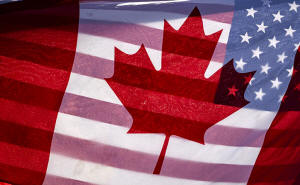US economic worries mount as Trump implements tariffs, cuts workforce
and freezes spending
[March 08, 2025] By
JOSH BOAK
WASHINGTON (AP) — With his flurry of tariffs, government layoffs and
spending freezes, there are growing worries President Donald Trump may
be doing more to harm the U.S. economy than to fix it.
The labor market remains healthy with a 4.1% unemployment rate and
151,000 jobs added in February, and Trump likes to point to investment
commitments by Apple and Taiwan Semiconductor Manufacturing Company to
show that he's delivering results.
But Friday's employment report also found that the number of people
stuck working part-time because of economic circumstances jumped by
460,000 last month. In the leisure and hospitality sectors that reflect
consumers having extra money to spend, 16,000 jobs were lost. And the
federal government reduced its payrolls by 10,000 in a potential
harbinger of the alarm being sounded by the stock market, consumer
confidence and other measures of where the economy is headed.
Since January, the economic policy uncertainty index has spiked 41% to a
level, 334.5, that in the past signaled a recession. Nicholas Bloom, a
Stanford University economist and co-developer of the uncertainty index,
said it's unclear how this will play out, but he's worried.
“I have an increasing fear we will enter into what may become known as
the ‘Trump recession,'" he said. "Ongoing policy turbulence and a tariff
war could tip the U.S. economy into its first recession in five years.”
That last recession occurred under Trump because of the coronavirus
pandemic.

For his part, Trump seems comfortable with the uncertainty that he's
generating, saying that any financial pain from import taxes is a mere
“disruption” that will eventually lead to more factories relocating to
the United States and stronger growth.
If Trump's gambit succeeds, the Republican would cement his reputation
as an unconventional leader who proved doubters wrong. But if Trump's
tariffs backfire, much of the price would be paid by everyday Americans
who could suffer from job losses, lower wages, higher inflation and,
possibly, an injured sense of national pride.
In an interview to air Sunday on Fox News' “Sunday Morning Futures,”
Trump was pressed to provide some clarity on his tariffs agenda that has
caused uncertainty to fester. The president largely hedged his answer
and blamed the 6% drop in the stock market over the past two weeks on
“big globalists.”
“You know, the tariffs could go up as time goes by, and they may go up
and, you know, I don’t know if it’s predictability,” the president said.
The White House maintains that Friday's jobs report showed the
administration's strategy is working because manufacturers added 10,000
jobs. Of the manufacturing gains, 8,900 jobs came from the auto sector,
recovering some of the industry's job losses in January. The White House
also suggested that the loss of leisure and hospitality jobs was the
result of flu season and people having depleted savings and credit card
debt because of President Joe Biden's term.
“I thought it was a really, really impressive jobs report,” Kevin
Hassett, director of the White House National Economic Council, said of
Friday's numbers.
Hassett said the additional factory jobs were the result of companies
“on-shoring” work because of the coming tariffs.
“This is the first of many reports that are going to look like this,”
Hassett said with regard to the hiring in the industrial sector.
The stock market selloff raises doubts about whether tariffs will create
the promised jobs.
“Markets anticipate,” said John Silvia, CEO of Dynamic Economic
Strategy. “The turn down the dark alley of tariffs signals higher
inflation, slower economic growth and a weaker U.S. dollar. It is an
economic horror movie in slow motion.”
Trump has instigated a trade war in the last week with Canada, Mexico
and China, only to then hit a monthlong pause on some of his import
taxes because of the threat to U.S. auto factory jobs and because of
Mexico's latest efforts to curb fentanyl smuggling.
[to top of second column] |

Sunlight shines through the flags of Canada and the United States,
held together by a protester outside on Parliament Hill in Ottawa,
Feb. 1, 2025.(Justin Tang/The Canadian Press via AP, File)
 More tariffs are coming on April 2
for Europe, Trump says, possibly putting the United States into open
conflict with a continent it helped rebuild after World War II.
South Korea, India and Brazil could also face new tariffs, Trump
said in his address to a joint session of Congress on Tuesday.
Silvia said Trump’s tariffs need to be more targeted with regard to
products and nations and set at lower rates, adding that doing so
would provide an assurance that there is solid research backing the
measures.
There were multiple signs of uncertainty and concerns about the
tariffs in the Federal Reserve’s beige book, a collection of
anecdotes from hundreds of businesses that the Fed releases eight
times a year.
Published Wednesday, the beige book included 47 references to
uncertainty, up from just 17 in the previous edition in January.
“Many businesses noted heightened economic uncertainty and expressed
concern about tariffs,” the Fed’s New York branch reported. “Looking
ahead, businesses were notably less optimistic.”
“This is the perfect storm for businesses,” said Brian Bethune, an
economist at Boston College. “How can you possibly plan anything in
this environment?”
Still, Treasury Secretary Scott Bessent said Friday on CNBC that he
sees positive momentum in combating inflation. He said crude oil
prices have fallen since Trump's inauguration, as have the interest
rates on 10-year U.S. Treasury notes and mortgages.
Still, interest rates on government debt are higher than they were
last year in September, and the recent decline could reflect a
slowdown in economic demand.
Bessent suggested a core problem is that the U.S. economy has become
overly reliant on government deficits and that the Trump
administration would be fostering stronger growth in the private
sector.
“We’ve become addicted to this government spending, and there’s
going to be a detox period,” he said.
This particular form of economic rehab is coming from Trump’s
Department of Government Efficiency, which is led by T-shirted tech
mogul Elon Musk, the owner of Tesla, X and SpaceX, among other
companies.
The alleged savings by DOGE are still too paltry to bend the
troubling trajectory of the national debt that is largely being
driven by tax revenues that are insufficient to cover the rising
costs of Social Security and Medicare.

But the initiative has started to downsize the federal workforce in
ways that could surface in future jobs reports. Roughly 75,000
employees took the deferred resignation plan. There are also
thousands of probationary federal workers who were fired and tens of
thousands of layoffs to come based on the administration's plans.
Asked Friday in the Oval Office if the government layoffs could hurt
the overall labor market, Trump said the economy would be great.
“I think the labor market is going to be fantastic, but it’s going
to have high-paying manufacturing jobs,” he said. ”We had too many
people in government. You can't just do that."
___
AP economics writer Christopher Rugaber contributed to this report.
All contents © copyright 2025 Associated Press. All rights reserved |